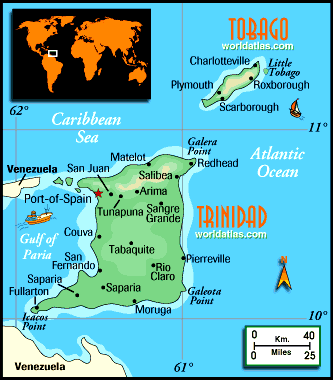That's right, we'll be enjoying a yet to be determined number of days and nights at the very bottom of the Lesser Antilles. Or off the coast of Venezuela, depending on how you look at it. My glass is double-full, I see both!
 Map courtesy WorldAtlas.com
Map courtesy WorldAtlas.comThe quiz questions were designed to slowly help you narrow in on the single location that matched the suite of clues. OK, "designed" is a bit strong, let's just say it "worked out." Let's check out where I was hoping the questions would guide you. Each one should have cut out several possibilities, but I won't list all of them here.
First, remember I was planning to go somewhere "exotic." That should have pointed you away from the U.S., though you never really know: Big Bend in Texas, the Sonoran Desert . . . we live in a richly diverse country, with amazing habitats and exotic species, at least to this New Yorker. But here are the boundaries:
1. Climate
The average temperature in October is reported to be between 76* - 80*F, average rainfall in October is approximately 6.7 inches.
Hopefully this made you think sultry temperatures and fairly frequent rainfall. Probably somewhere tropical or subtropical.
2. Topography
The land is primarily mountains and plains. Naturally occurring wetlands include freshwater marshes, mangrove swamps, lagoons, and marine ecosystems.
Well, that seems to describe most tropical countries, but now we know there's a coast. Mangrove swamps? Clearly somewhere tropical or subtropical.
3. Geographic Location
We will not cross the equator.
That lops out a whole lot of locations, we can focus on tropical locations north of the equator. But I never did limit our destination to the western hemisphere, but that seemed to distract nobody.
4. Culture
The official language is English. We will need passports and to figure out the currency.
Cuts out many more countries, but there are several that require passports and have English as their official language - Jamaica and Belize are excellent deductions! As was T&T.
5. Economy
The infrastructure is excellent, including an international airport, an extensive network of paved roads, modern hospitals, and reliable utilities. At least in the cities.
I'm not sure that disqualifies anywhere at this point, does it? But at this point we know we're looking for an English-speaking, non-American location with a tropical/subtropical climate that boasts a coastline and mangroves lying north of the equator. A few Central American and Caribbean countries certainly qualify. There are probably some African or far eastern countries that fit (but I'm not sure which, and you all seemed to have figured out we're staying in the western hemisphere).
6. Climate
October is both in the wet season and the hurricane season, though we're not really worried about the latter. If we're lucky we won't worry much about the former, either.
In addition to being smack dab in the "Hurricane Belt," Puerto Rico is a US territory: no passport or currency exchange required. The Hurricane Belt factor also eliminates Jamaica, Belize, the U.S. Virgin Islands . . . well, everything except a small handful of islands in the very southern portion of the Caribbean. So, we're left with those choices and perhaps a few islands in the Pacific (that likely don't fit all of the previous criteria). By now you can safely surmise Trinidad and Tobago. All of the other Caribbean, Central American, or northern South American possibilities don't meet all the criteria.
7. Geology and Heritage
Geologically this country belongs to one region, but geographically it's considered part of a different region.
Trinidad and Tobago fits here: geologically part of the South American plate, but culturally considered part of the Caribbean Islands.
8. Flora and Fauna
There are over 400 bird species on the official checklist (466 to be precise). Only one is endemic.
There are a few other islands that have a single endemic, but not over 400 birds on their checklist. Not to mention they don't meet the other criteria.
A hearty congratulations to Nate of The Drinking Bird, not only for correctly pegging the location by the fourth clue, but naming the sole endemic I'll be targeting on our trip (among the other 465 birds, of course), the Trinidad Piping Guan. I hope to be posting about an encounter sometime in late October.
I didn't offer a prize at the outset - I'm not a big proponent of extrinsic motivation, so kudos and thanks to all who participated. But I feel I should offer something to the winner.
So, Nate, if you email me your mailing address I will happily send you one (1) postcard from the islands, replete with a personalized message written by me,* postmarked from T&T.
* Disclaimer: I may pawn off the actual writing of the message to my daughter. She may also choose the postcard. I will pay for the card and the postage.
-















































